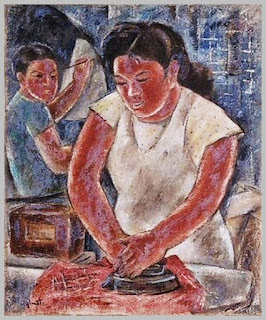From the archives of All things Ironing - How is an Iron Constructed.
The information in this article is drawn from an Iron manufacturer's Iron Construction manual and various websites. Links to images and related websites are located at the bottom of this article.
Raw Materials
Irons are made primarily of plastic and metal. The materials often comes to the factory in the form of plastic resins, aluminum ingots, and steel sheets.
The metal is used to make the sole plate, thermostat and other internal mechanisms. Plastics are used to make the exterior and handle, as well as the water tank. Certain components, like the spring for the thermostat, cord, plug, and related connections are usually outsourced by iron companies.
 |
| Iron |
The Manufacturing Process
Each sub-assembly of the iron is produced, most often on separate, automated production lines. Then the iron is assembled.
Sole plate
1 The sole plate is cast from molten aluminum in a mold that already includes the steam holes.
2 The sole plate is then polished, coated with a variety of non-stick materials including teflon.
3 To polish the plate, an automated belt sander uses bands of abrasive to polish and buff the plate. The finish required determines which grade of abrasive is used.
4 An automated spray-painting machine applies non-stick coating. After application, the sole plate is baked in an automated industrial process.
5 To coat with another metal, the external metal cover is created by an automated stamp press. The resulting cover is either pressed or riveted onto the sole plate, through a smaller machine press.
Examples of soleplate types
 |
| soleplate - explained |
 |
| soleplate - diagram |
 |
| soleplate - steam holes |
 |
| soleplate - stainless steel |
 |
| soleplate - panasonic 360 |
 |
| soleplate - sunbeam Verve |
 |
| soleplate - rowenta |
Thermostat
6 In an injection mold, a small metal post is cast.
7 A spring is mounted onto the metal post. This spring is a bimetallic switch made of two different metals with divergent linear thermal coefficients bonded together. The spring actually controls the iron's temperature.
8 Power contacts are attached to the end of the spring, which let the electricity through so the iron can be heated. This whole process is generally automated.
 |
| iron thermostat |
 |
| iron thermostat diagram |
Water tank
9 In a two-part injection mold, heated plastic is inserted to make upper and lower sections of the tank. Several openings on the tank are created as part of the mold.
10 The mold is put under pressure, cooled, and released as a one-part tank.
11 Other parts for the tank (pump, internal chamber, piston, buttons, and other parts) are created by similar injection molding processes.
12 On an automated assembly line, the parts are put together, with each of the other parts put onto the water tank.
Housing
13 In an injection mold, heated plastic is inserted into a mold under pressure, cooled, and released.
Handle
14 In an injection mold, heated plastic is inserted into a mold under pressure, cooled, and released.
Assembly
When all the parts are manufactured, the iron is assembled on an automated assembly line.
15 The sole plate is the first part on the assembly line. The thermostat is either screwed onto the plate, or welded to the plate by a robot.
16 To the sole plate-thermostat subassembly, the water tank is put in place. It is secured on an automated line with screws or other industrial fasteners.
17 The handle and body are attached over the sole plate, thermostat and water tank, and fixed by screws. Sometimes this process is automated, but it also can be done manually.
18 The electrical cord is the last piece to be added. Sometimes this process is automated, but it also can be done manually.
19 After an automated testing process, the irons are inspected by hand.
20 Completed irons are packed into indidual boxes with instructions and other documents by hand. (For some companies, this is an automated process.)
21 The individual boxes are placed in shipping cartons or master packs for distribution to warehouses.
Quality Control
Before the manufacturing process begins, all the raw materials are sample checked for consistency. As each subassembly of the iron is manufactured, the pieces are checked for correct functionality.
During the assembly process, an iron is removed from the production line and taken apart by an independent department to look for errors. Any mistakes result in the whole batch of irons being checked and corrected if necessary. After the product is assembled, a worker also checks the iron for electrical functionality and water integrity.
Byproducts/Waste
Any excess metal or plastic from the molding process is reused in the process, if possible. Anything that is unable to be used is recycled.
The Future
The most obvious improvements on the iron probably will be to the sole plate. Better coatings will probably be invented that are more resistant to damage from zippers or other protrusions on garments and reduce drag over fabric. These improvements might be in the form of better alloys or better nonstick coatings. Internal mechanisms that better control heat and steam also will continue to evolve.
research links & image sources :
freepatentsonline
panasonic 360
advantech
artofmanliness
alibaba
brighthubengineering















+Young+Woman+Ironing,+1800+framed.jpg)































